Oxford College isn’t just a part of Emory University’s story—it’s where the story begins. Located…
Emory’s Top 10 Most Iconic Campus Features
Emory University was founded in 1836 on what is now the Oxford College campus. With nearly two centuries of history behind it, you can be sure it has some historic–and interesting–sites to see around both of its campuses.
Today, we’re going to outline the top 10 most iconic campus features Emory University has to offer.
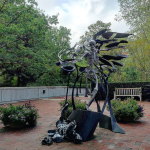 10. The Dooley Statue
10. The Dooley Statue
Dooley, “the Lord of Misrule,” is a figure that embodies “the spirit of Emory.” For years he’s been represented by a student who roams the campus wearing a top hat, a black sheet painted with bones, and a skull mask. He’s so much a part of Emory lore that sculptor student Lance Henry decided Dooley should be honored with a statue in Asbury Circle.
Students have been known to drop coins into his outstretched top hat for good luck–and also dress him in festive costumes for holidays.
 9. The Lullwater Preserve
9. The Lullwater Preserve
If you’re in the mood to get away from the bustle of the Atlanta campus, Lullwater Preserve offers many scenic trails–just steps from university buildings.
You can visit the Lullwater House mansion, Candler Lake and cross a bridge to explore an old mill beside a rushing waterfall. Taking to the trails proves to be a perfect study break for many students.
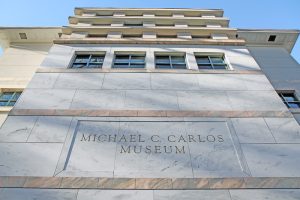 8. The Carlos Museum
8. The Carlos Museum
The Michael C. Carlos Museum is an art museum located on the historic quad of Emory University’s main campus in a century-old building. This institution preserves, exhibits, and interprets art and artifacts to educate the community, while promoting learning and research at the university.
The museum originally housed the university’s School of Law, and if you look closely, you can still see the carvings that show the scales of justice and the Mosaic tablets of law under the building’s eaves.

7. Asbury Circle
Asbury Circle is an outdoor space located between Dobbs Hall and the Anthropology Building that hosts student-led and university activities.
Wonderful Wednesday is a weekly celebration held on Wednesday afternoons in Asbury Circle that allows students, staff, and all members of the Emory community to gather together for special themed events.
 6. Johnson Hall
6. Johnson Hall
Formerly Language Hall, Johnson Hall is one of the oldest buildings at Oxford College–and therefore one of the oldest buildings at Emory University.
During the six months of restoration ten years ago, preservationists discovered several artifacts from the building’s past. One of the unearthed blackboards now on display behind glass on the building’s second floor bears these words: “Smith. Oxford, Ga. June 26, 1941. Be sure you are right. Then go ahead.”
 5. The Emory Entrance Sign
5. The Emory Entrance Sign
Located just steps from the Haygood-Hopkins Memorial Gateway at the main entrance of the Atlanta campus, the Emory entrance sign welcomes all visitors to the university while showing off some interesting trivia at the same time.
You’ll notice the university seal with a crossed torch and trumpet. The torch represents the light of knowledge while the trumpet represents the dissemination of knowledge. This imagery conveys the university’s goals, which still hold true today.
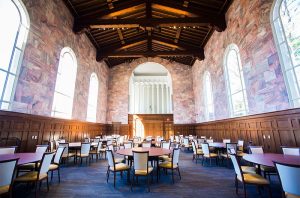 4. Convocation Hall
4. Convocation Hall
Convocation Hall was built over a hundred years ago and has the distinction of being one of the first two buildings constructed on the Atlanta campus. It currently houses prominent offices and plays host to a number of university events.
Originally known as the theology building, you can visit the building on Emory’s quadrangle. Much like the Carlos Museum building, Convocation Hall bears some hallmarks of its original purpose as the theology building: you’ll see marble reliefs of crosses and thorns adorning its facade.
 3. Seney Hall
3. Seney Hall
Built in 1881, the red brick Seney Hall is Oxford College’s most famous building. It is one of Emory University’s oldest and most recognizable landmarks. It was named after Emory College donor George Seney, a Methodist layman from Brooklyn, New York.
The bell chimes in the clock tower atop Seney Hall every half hour. Cast in 1796, it is the oldest artifact at Oxford College.
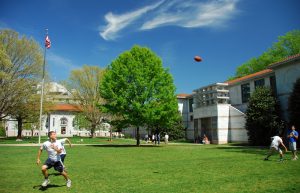 2. The Quad
2. The Quad
Designed in 1915, the Emory Quadrangle on the Atlanta campus was–and still is–an anchor point for many of the university’s key buildings like Convocation Hall and Candler Library. It’s so picturesque that it’s a popular spot for filming movies and TV shows.
The quad features sprawling lawns that make it the perfect spot for some grassy respite between classes. Some say it’s shaped like a Coca-Cola bottle–you’ll just have to visit to find out!
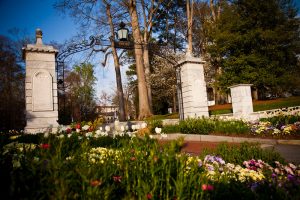 1. Haygood Hopkins Gate
1. Haygood Hopkins Gate
The Haygood-Hopkins Memorial Gateway was built in 1937 and named after two of Emory’s presidents. Alumnus Linton Robeson (Emory Class of 1886) meant to deepen the connection between Emory’s newer Atlanta campus and the original campus in Oxford, and worked to get the gateway constructed.
It is seen now as the traditional entrance to the Atlanta campus. The gate is located at the intersection of North Decatur and Oxford roads.
Ready to Visit?
Whether you’re in the mood for a nice walk in the woods, a picnic with friends in the quad, or to just pay homage to the wonder that is Dooley, Emory University is filled with iconic landmarks and treasures to enjoy. If you’re interested in visiting, you can find more information here.



This Post Has 0 Comments